Traps, Overloads and Vertical Transitions – Benitez’s Everton’s Use of Wide Pressing Traps and How It Can Facilitate the Toffees in Possession Approach
As Everton meandered to another mid-table finish in Carlo Ancelotti’s first full season, something which has become more common than not in recent years, it suffices to say Everton fans looked ahead to the summer transfer window wondering what direction Ancelotti and Marcel Brands would take Everton’s squad, some with trepidation considering the scattergun recruitment of the club in recent years.
However, the Merseyside team saw their plans thrown into disarray when Ancelotti was chosen by Florentino Perez to return to Real Madrid at the start of June, leaving Everton searching for another permanent manager, another common feeling for Everton and its fans in recent years. Following a three-week managerial search, Farhad Moshiri and Everton turned to Rafael Benitez on a three-year contract to lead the team into the upcoming season and beyond.
The appointment was met with wide-reaching dissatisfaction from the fans, largely due to his connection to the red side of Merseyside following a six-year spell at Liverpool which firmly entrenched his name in European coaching circles, as well as his more functional approach that is associated with his last Premier League job at Newcastle. Whilst these were the concerns of the fans, Moshiri referenced his major honours from his time at Valencia, Liverpool, Chelsea and Napoli and his pedigree as a “winner”.
The concerns about Benitez and Everton’s direction appeared to be compounded by their transfer activity, which has seen a combined outlay of 1.8 million pounds. However, fast forward three-game weeks into the Premier League season, and Benitez’s Everton have picked up 7 points from their first three games and navigated the second round of the Carabao Cup.
This can be considered a positive start, albeit against opponents who finished mid-table and lower last year, and these games have also given a clear early indication as to the Spaniard’s desired approach in the coming season, and some of the principles that he is trying to impart on this Everton squad.
Important caveats to this early tactical analysis of Everton include the opponents Everton have faced, the styles these teams play, for example, Leeds under Marcelo Bielsa play with an intensity unmatched by others, with their games quickly becoming very transitional and more open, and whether the ideas implemented in these games are specific to that match or are occurring as Benitez tries to stamp his mark on this team.
However, as will be discussed, the wide areas have been extremely important to Everton’s early approach, both offensively and defensively. Defensively, these areas have been vital to their press, with their use of wide pressing traps that when structured correctly have helped them turn over the ball and set them up in transition. The last point will also be explored, how the principles and ideas in the pressing traps also aid their more direct possession approach.
Wide Pressing Traps
Before assessing the more tactical nuances of their defensive approach so far this season, it is important to identify the general shape Everton employ. The predominant shape Everton have employed is the 4-4-2, both in and out of possession, having briefly opted for a 4-2-3-1 shape against Southampton in the opening game.
Throughout the first game weeks, Everton’s pressing system against teams looking to build-up has seen Everton using passes to the opposition full-backs as the primary pressing trigger, with the movements of the forward two players designed to funnel any central possession into these areas. When pressing the wide areas, the Toffees look to spring pressing traps to try and win the ball back.
The first aspect of Everton’s press in a mid-block against the opposition is the movement of the two forward players, which have been Dominic Calvert-Lewin and one of Richarlison or Demarai Gray. When one of the opposition CB’s have the ball, irrespective of the build-up shape they employ, the ball-side Everton striker will approach the opposing player with a curved run on the inside of the player.
Whilst a basic concept and widely employed, the angle and position taken closes the passing lane back across the pitch to the other CB or the other players situated in front of Everton’s first line, thus limiting their options for passing to either the full-back, or a central player who is making themselves available, between the lines, or in front of Everton’s second line of defence.
An example of the positioned run on the inside of the opponent can be seen in the below example taken from the Southampton game, where the angled run places the opposition midfielder in the cover shadow, closing a central passing lane, closes a lateral passing option to the centre of the 3 players in Soton’s build shape, and lastly, the orientation with open body towards the touchline encourages the Southampton player (Mohammed Salisu) to either drive wider or play the pass to the FB on the touchline.
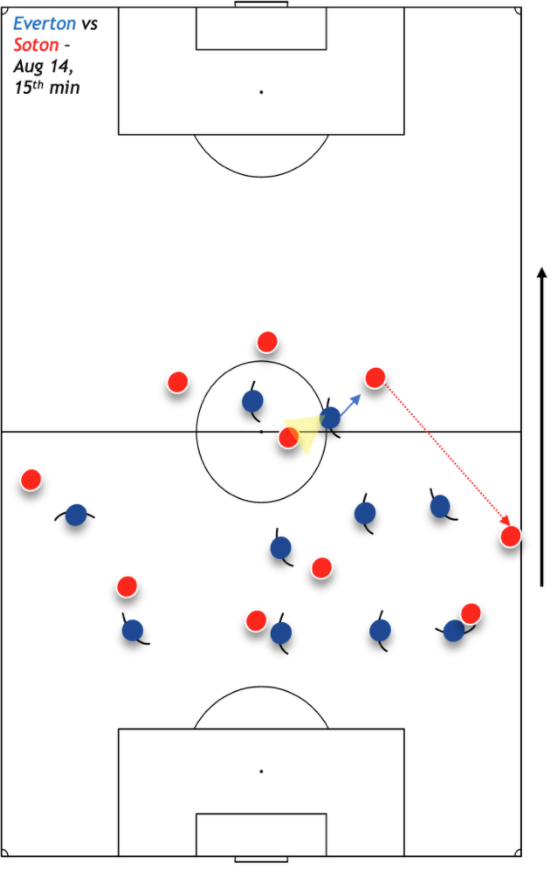
The opponent’s centre back, with limited options ahead, will typically opt to pass wide to the full-back who is free. The wide midfielder in this scenario retains a good starting position, with the 4-4-2 providing good lateral coverage, and with no specific instructions to stay narrower, the wide player retains initial proximity to the opposing full-back.
Upon passing, the wide midfielder instantly closes the space and presses the opposing player, looking to win the ball back in the first instance, with the second goal being to delay any further forward or progressive actions.
The angle of the press here again plays a pivotal role in preventing this, as the wide player presses the player from the front, forcing them to orientate towards the line, or to pass the ball backwards, closing the more dangerous central areas.
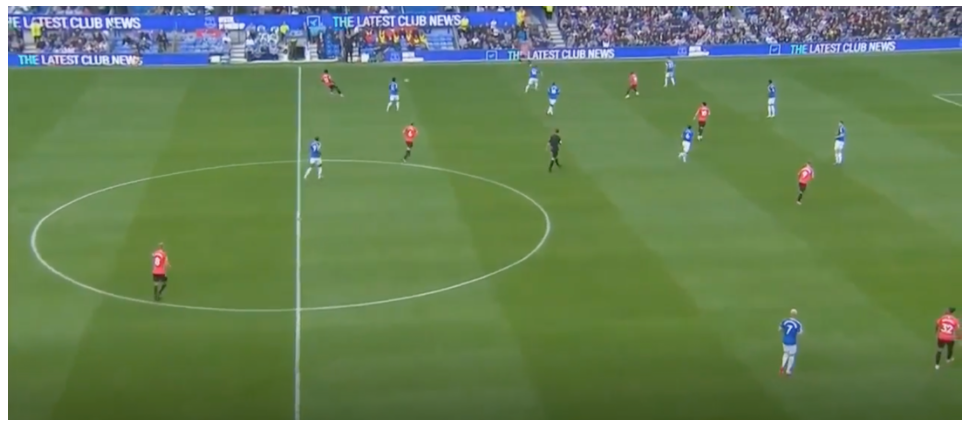
Upon this trigger, Everton also commits further bodies to the wide area that is being closed down, effectively creating a pressing trap to force a favourable scenario for the ball to be turned over. Any combination of the ball side full-back, ball side central midfielder, winger and striker will commit to the press on this side, leaving three to four players swarming the wide area.
This will close the space significantly, shutting many passing lanes, and any opposing players are being tracked into this area of the pitch meaning they are an unviable passing option. In this example, Doucoure, the ball side CM, Demarai Gray and Andros Townsend rapidly shut the space out wide as evidenced in the diagram, swarming the two Southampton players and closing all passing lanes, forcing Romain Perraud backwards.
Beyond the initial 3v2 trap, Dominic Calvert-Lewin and Seamus Coleman are stationed to either mark an option tightly, or to close further passing lanes as DCL is doing, rapidly increasing Everton’s chance of a turnover. In this instance, a deflected pass off Gray when Perraud tries to pass backwards creates a potential turnover scenario.

Another important aspect of Everton’s traps in these wider areas is the use of the touchline as the 12th man. Often when a full-back or winger receives in these wider areas, they are orientated towards the pitch with their back to the touchline or edging towards being side-on to open up the game in front of them down the flank.
With the touchline behind the player, this effectively operates as the 12th man as they are unable to move via this angle, doing a ‘pressuring’ job for the defensive team. Therefore, it only leaves 3 of 4 angles for the player to then move from this position – centrally, backwards towards their own goal or forwards down the line.
In the above scenario, you can see how their pressing traps have incorporated this concept, with the players closing down the remaining options and angles without overloading the area numerically, and has been a common feature of their pressing throughout the first three Premier League games.
For instance, against Brighton in the 10th minute, following a sequence of build-up deep in Brighton’s half, Webster central lanes blocked off, Adam Webster passes to Pascal Gross, who receives in the RB / RWB area, oriented with his back to the touchline. Everton’s press reflects this and utilises the touchline as an additional player effectively, with Gray, Abdoulaye Doucoure and Lucas Digne closing the spaces and angles of the three remaining options for Gross in a 3v3 scenario.
This is seen in the diagram below with the pink areas highlighting the ‘controlled’ areas for Everton’s players, which include the angles they are blocking and the cover shadow of their press. With limited options, he delays, and with no options presenting themselves, he turns and kicks long, with Everton recovering this pass and turning the ball over.

Once again, as before, beyond the initial press, there are safeguards that allow Everton protection beyond the press. The LCB is well-positioned to sweep behind the LB and the ball-side striker and other CM are additional marking or angle closing options. This effectively sees Everton have six of their players maintain good proximity to the ball carrying out important roles within the press, almost a defensive overload within the right third of the pitch.
In addition, this particular sequence also highlights the intelligence within Everton’s pressing in the early games, with the players recognising a scenario where the immediate pressure on the player was not as necessary as closing all options whilst maintaining a few yards distance, limiting Gross’s next option instead of looking for the immediate turnover.
When executed successfully, Everton’s pressing traps have formed the foundation of their defensive game. However, there are also a number of structural weaknesses of this approach including the opening of space centrally and far-side if an opposition breaks the press and the demands it places on the central midfielders.
Firstly, overcommitting to certain areas of the pitch to win the ball back in numbers inevitably opens up other areas of the pitch. Therefore, if the opponent breaks the press, they have ample space to operate in. This became more pertinent against Leeds, and then even more obvious against Brighton when Benitez’s team were clearly instructed to press higher with greater frequency against the Seagulls’ deep circulation, opening the pitch up significantly more in doing so.
One example of the wide pressing traps being broke occurred in the 49th minute of the Brighton game. With Brighton employing three at the back, it was fairly common that the wide CB would be the receiving player of the pass in a wide area, which Everton would then be using as the first pressing trigger. When received out wide, Gray and the ball side ST pressed the Brighton player in possession, closing central lanes.
However, Brighton retained numerical superiority, as Doucoure (boxed in green) could not get higher to support the press and obtain numerical parity and the complete shutting down of angles. As such, Gray opts to close the central passing lane which allows the player to carry the ball down the line and break the pressing trap. Given the committal to the trap, Everton has at least 5 players on the left side of the pitch in the opposition half.
After carrying the ball, Webster plays a pass infield, to a teammate who is in significant space with vertical passing options (wide and centrally) as Everton, particularly their midfield presence, has shifted to the ball side, demonstrating the dangers of the press being broken as the space that then opens up. The end of the sequence saw Leandro Trossard miss a shooting opportunity from within the box after the ball had been worked to the underloaded side.
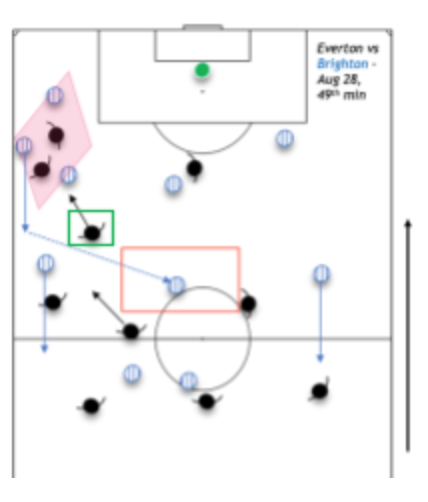
Secondly, in this approach, the demands placed on the central midfielders shuttling side to side and being key elements of pressing traps on both sides, are significant. Outside of the pressing traps, they are also required to fulfil box-to-box roles within Benitez’s 4-4-2 and contribute to similar wide overloads defensively deep in their defensive third.
Through the first set of games, Allan and Doucoure both rank in the top 15 for pressures applied per90 for players who have played more than 1.5 90s. In an absolute sense, the two players account for 34% of the team’s total pressures attempted over these three games. Whilst this also reflects their role at pressing passes that break the lines centrally and the requirement for them to support defending the wide areas in their defensive third, it highlights their all-encompassing roles which includes their involvement in wide pressing traps.
Outside of Allan and Doucoure, Everton’s depth in this area could be questioned, with the exception of Tom Davies being able to carry out the role to the intensity required, as players such as Andre Gomes will likely struggle to meet the intensity demands required of the two central midfielders. This could pose a dilemma in the event of injury or as fatigue sets in as the season wears on, as in the above example if the midfield players cannot support in achieving parity or overloads, the structure of the press is easily broken.
Throughout Everton’s opening games, the wide pressing traps were a common feature of Everton’s press, and when they have structured the press correctly and executed well, the Toffees have stymied opposition ball progression and created favourable turnover position with their wide pressing traps. The tenets of the wide pressing traps, notably the number overload ball side and intensity are reflected in their overall approach to defending through Benítez’s early games.
In the latter stages of the games, likely reflecting i) game state and ii) fitness, Everton’s carrying out of the press has dwindled. It is reported that the Spaniard has upped the intensity of training sessions to improve fitness, which will be a significant factor in the future success of their ability to carry out this approach effectively going forward.
As the season wears on, it will be interesting to see whether Benitez and Everton stick to this approach, and work on coordination and structure to really lock down the wide areas, or whether the physical demands of the approach and the potential holes in the pressing force Everton to adapt.
How Does Everton’s Favoured Pressing Mechanism Facilitate the Toffees in Possession Approach?
As the fluency of attacking and defending is now being recognised and not discussed as two distinct units, it is important to consider how Everton’s defensive approach in these phases of play greatly facilitates how the team are in possession when transitioning to attack.
On the whole, Everton’s in possession approach under Benitez to date has focused on being direct, using the mobility and physicality of DCL and Richarlison, and creating favourable situations in wider areas to lead to crosses or the wide players attacking the box.
With the emphasis on wide pressing traps and overloading these areas, this approach generally facilitates this direct approach, with the team able to underload the opposite flank and play quick releases to these areas as well as setting up Everton for wide combination play with ball side overloads.
Quick Releases in Attacking Transitions to Forward Players
As Everton commit significant numbers to their wide pressing traps in an attempt to close the operative space for the opposition, with as many as five or six of Everton players playing primary or secondary roles in the traps, the Toffees regularly are left with ball-side overloads of players.
How Richarlison’s Role Has Changed Since Being Deployed as a Striker
This essentially means Everton have a large number of bodies in one defined smaller area of the pitch. Whilst as mentioned, this approach cedes significant space elsewhere if the opposition breaks the press, the same modus operandi applies to Benitez’s team when they turn over the ball.
When transitioning to attack, with one scenario as such occurring when successfully operating the wide pressing traps, Benitez’s team look to spring counter attacks by releasing the ball quickly vertically, either to a striker or wide player, who should be receiving in space or 1v1 against a defender with the majority of play shifting the original ball side.
The current approach to wide pressing traps facilitates this approach through the overloading and underloading of the pitch in certain areas, allowing for space elsewhere on the pitch to facilitate this movement. In this example of setting up quick vertical attacking transitions, upon the pass going out to the wide player Harrison from Dallas, Coleman presses from RB with Townsend pressing from the inside to block central and backwards lanes.
Supporting the 2v1, Doucoure is positioned by Tyler Roberts to mark him in the event he pushes wider, to maintain numerical superiority for Everton when pressing. With limited passing options, Harrison is snuffed out by Coleman as he dribbles centrally.
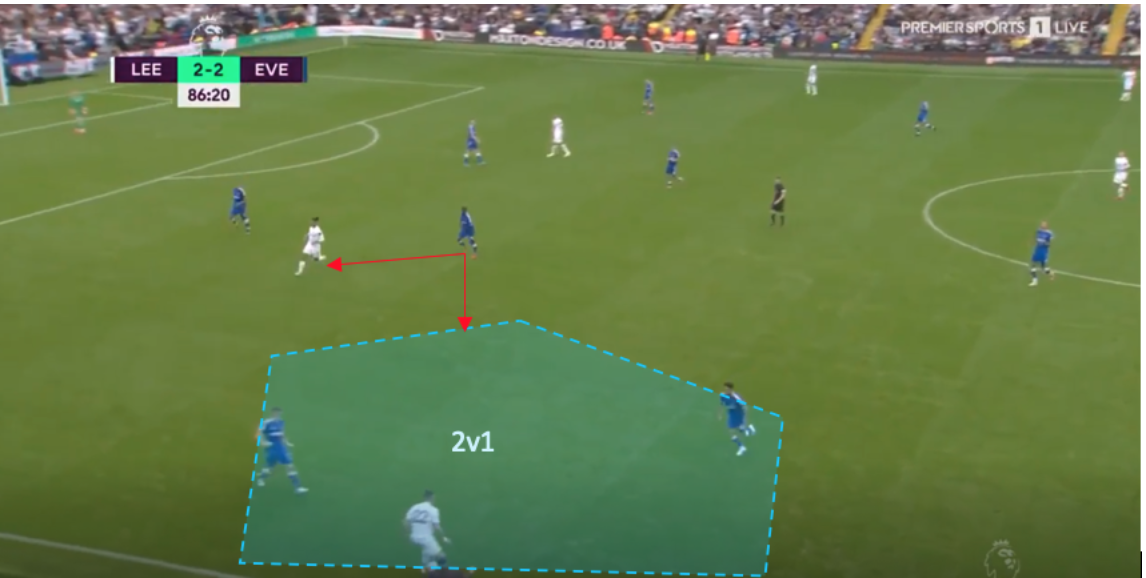
Upon being dispossessed, the Everton player in possession has a number of options for immediate or second chain vertical progression due to the positioning of the players on the pitch post pressing trap. The first options are playing lateral passes to the left midfielder who had tucked in here, although usually, the left midfielder would be attacking the orange space on the flank (if Gray / Townsend etc were playing there), or to Allan, who then are facing play with the opportunity to play quickly forward.
The second option that facilitates vertical transition play is the deep central midfield positioning, which is reflective of their roles in supporting the press, and cedes central space which Coleman wins the ball back in, and supports quick vertical passing into the two forward options, which eventually happens into Richarlison for Everton to break (red line) as they have space to receive and drop into as they typically stay higher to create that space.
This would normally be one option if the ball side ST supported the press. The third option, if as noted, it was a winger instead of Fabian Delph, the underloaded side presents itself with a large amount of space as denoted by the orange box on that side, and a potential 1v1 isolation which has been a key tenet of Everton’s early attacking play and has led to final third production early this season.
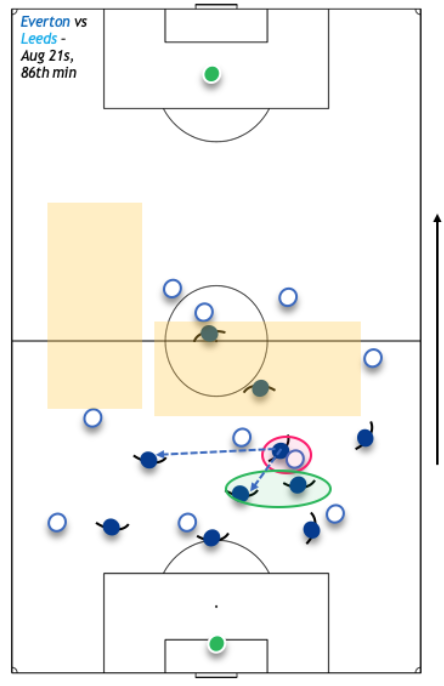
Whilst this is just one example, the wide pressing traps support Everton’s desire to be vertical and direct in transition, through the positioning of the CM’s, the space for the strikers and the underloaded side option.
Wide Combinations
Another aspect of Benitez’s Everton so far has been the attempted wide combinations to create crossing opportunities having packed the box with bodies. As noted throughout this article, the wide pressing traps create overloads from a defensive sense, however, this also then applies instantly upon turnover, with Everton now having numerical overloads in possession. For combination play to be its most effective, overloads are required to be able to manufacture the space and use the spare man to progress the ball effectively.
An example of this can be seen in the 53rd minute against Southampton. Che Adams receives the ball deep, collecting a pass from Salisu, before playing it out wide to the full-back, Perraud. Upon this trigger, Townsend, supported by Coleman, Doucoure and more secondary, Allan, execute a wide 3v3 pressing trap, with Coleman, winning the ball upon a forward pass into the opposing winger, as denoted in the green triangle area.
Going beyond that, initially assessing their positions on the pitch upon the ball breaking down sees that Everton have a heavy numerical superiority, especially considering Adams is making a run forward as denoted in red, dragging himself away from the space. All things considered, upon breakdown, the Toffees have a 3v2 scenario out wide, with support by Allan in the second phase to make that a 4v2, and are positionally superior noting their orientation towards the goal.
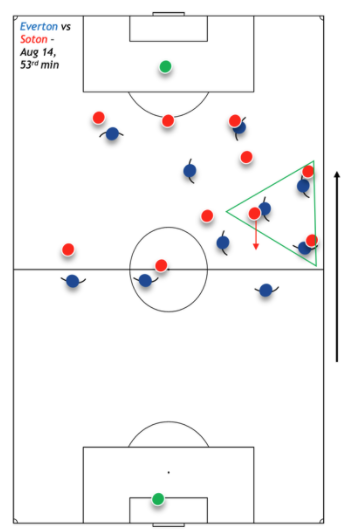
Collecting the loose ball, Townsend drags his full-back with him ever so slightly to open up the space behind him more, and take the full-back out of the game. He then immediately fizzes the ball infield to Allan, who can receive in space noting Adams run continued towards the halfway line. Coleman (circled in purple), having initially won the ball in the trap, makes an instant third-man run into the space behind upon Allan receiving the ball, who then chips the ball into the space for Coleman.
Whilst this sequence ended unsuccessfully, the immediate proximity of the players, the desire to combine and make runs with the initial overload allowing Allan to receive in space, is all a direct result of the structure of the wide pressing trap Everton conducted when the ball went wide to Perraud initially and shows how the traps can immediately facilitate Benitez’s desired approach in transition.
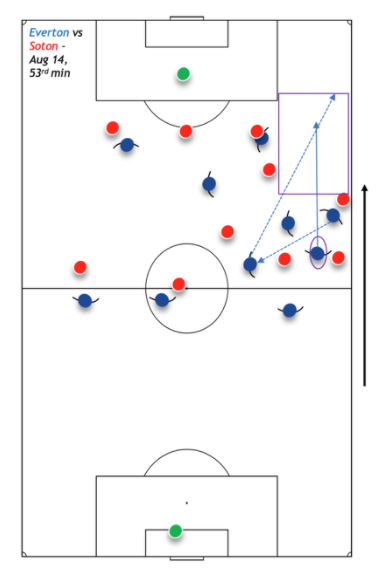
As with the quick vertical transitions, the overloading of the ball side that naturally occurs when pressing with wide traps helps Everton look to combine in wide areas, which has been a feature of their play prior to the first international break.
Concluding Thoughts
Although three games do not represent an opportunity for Everton to have displayed the full plethora of tactical principles and elements of Benitez’s desired game model for this squad, however, there have been a number of core tenets of this early Everton team.
Out of possession, there are intense and dogged, with their use of wide pressing traps vital to disrupting the opposition in build-up and progression, with a range of traps used to date, including 2v1, 3v2, as well as numerical parity traps with the touchline as a 12th man.
In possession, the word functionality springs to mind, with limited build-up structures and a penchant for going direct and using the physical profiles of their forwards, and the tricky, hard-working profiles of their wide players. These two units of analysis, whilst separate and can be viewed as such, need to also be viewed as one given the blurred lines between the two and often separated by a moment of transition.
This blurring of lines in Everton’s approach can be seen in how their use of wide pressing traps facilitates their ideals of going direct and being vertical in transition, by allowing them to combine in wide areas and spacing the pitch well to be vertical when they win the ball back after the successful execution of their pressing traps.
All in all, the ideas that Benitez is trying to implement appear to be filtering through well, and that is reflected in their early points tally. The game against Burnley presents a different challenge, and a game against a team with a style that is more akin to theirs, and it will be interesting to see how their approach differs based on this, having clearly displayed core tenets of their more coherent, functional approach so far.
By: @DHfutbl
Featured Image: @GabFoligno / Everton FC
